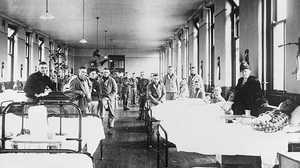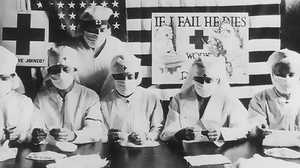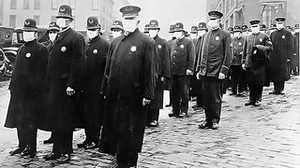Influenza 1918: Teacher's Guide
In the spring of 1918, as the nation mobilized for war, Private Albert Gitchell reported to an army hospital in Kansas. He was diagnosed with the flu, a disease doctors knew little about. Before the year was out, America would be ravaged by a flu epidemic that killed 675,000 — more than in all the wars of this century combined — before disappearing as mysteriously as it began.
![]() Influenza: Teacher's Guide (172.7 KB)
Influenza: Teacher's Guide (172.7 KB)
Time Period: 1918
Themes: influenza epidemic of 1918, World War I, public health policy, history of medicine
Before Watching
Divide students into two groups, and tell them they are going to see a film about a public health crisis. Make a list of what factors they think might have contributed to the spread of disease in 1918. Ask one group to jot down all the specific activities that contributed to the rapid spread of the disease. Ask the other group to note efforts by local or national officials to slow the spread of the illness and when these occurred.
After Watching
1. Put two columns on the board: “Factors contributing to flu spread” and “Actions of public health officials.” Using their notes, have the students complete the lists.
Looking back at the flu epidemic, what do students think should have been done to try to control the disease’s spread?
Why do they think these actions were not taken?
Then have groups of students study an infectious disease that has reemerged as a serious public health threat, particularly one we thought we had eradicated or controlled (e.g., tuberculosis, cholera, malaria, yellow fever, antibiotic-resistant bacterial infections, etc.), and develop recommendations for public health policy to halt its spread.
After each group presents and explains its recommendations to the class, encourage questions. For example: How will strategies be implemented? What are potential drawbacks? How can recommendations balance individual rights and the public welfare?
2. Why do students think Americans largely have not retained this incident in their collective memory? What do you think the impact of it was on those who lived through it? How much do you think the euphoria surrounding the Armistice overshadowed the experience of the epidemic? What can we learn from studying it? Is it an important incident to study? Why or why not?
3. According to the film, many people used home remedies to combat the flu. Have students choose different types of nontraditional medicine to research, including folk remedies, acupuncture, homeopathic remedies, biofeedback, or herbal remedies. They should look at the history of the practice, its strengths and weaknesses, and evidence of effectiveness. They might want to visit or interview staff at alternative medical establishments, homeopathic drugstores, acupuncture clinics, etc. Students may also want to look for parallels to traditional medicine (for example, willow bark and aspirin).
Students can create posters presenting their research, bring in pictures or examples of the medical practice they investigated, or share it through oral reports. What do students think should be the role of alternative medicine in treating illness? Do any of them use alternative medicine? If not, would they consider it? Under what circumstances?







